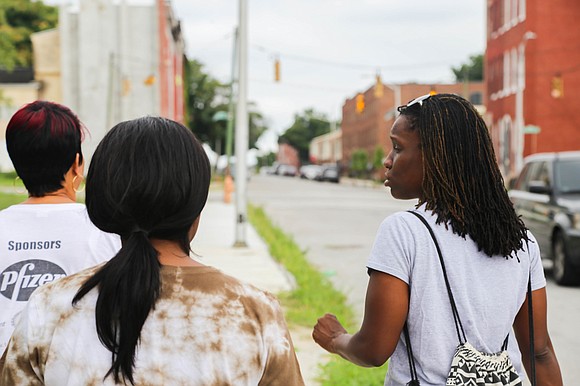N’neka N’namdi passionately believes that “A Blighted Baltimore is a Bleeding Baltimore.” And the entrepreneur and activist is doing something about it. In 2016, N’namdi founded “Fight Blight Bmore,” a social and environmental justice tool for residents to identify, report and track blight.
She calls Fight Blight Bmore (FBB), a campaign of people working together to cultivate safe, green, economically vibrant communities in Baltimore.
“On Mother’s Day 2016, I witnessed what could have been an awful tragedy about two blocks from my home,” N’namdi recalled. “A few children were riding their bikes down the sidewalk of Fremont Avenue, crossing Lafayette Street, where four brownstones were being demolished. The demolition site was filled with debris, gaping holes about six feet deep in the ground, with no gate to prevent site access.”
N’namdi witnessed the potential danger associated with those unsafe conditions like a child falling into the unsecured debris. It was on that day, and she said she began researching, documenting, reporting, and tracking environmental hazards created in part by the demolition sites around the city and the structures that preceded them.
“FBB was born as a call to action to address blight and the issues it causes for individuals and communities,” N’namdi said. “It provides a tool for more effective and efficient management of data and reports of blight. FBB is an environmental and social justice initiative, and the first part of this initiative is a mobile software application.
“The goal is to provide users with a tool to identify, report, and track blighted properties with the option to analyze collected and connected data sets.”
FBB also provides community education, which gives information to residents and community groups on what blight is and how it impacts people, neighborhoods, and cities’ health and economic wellness.
“Blight is complex. It is not simply ugly dilapidated buildings and eyesores within a city’s landscape,” N’namdi said “Blight equates to data that tells a deeper story of how municipalities invest and divest. Blight by the numbers also details the historical deprivation of particular communities and how they’re impacted by divestment.”
An educational initiative also is occurring through group dialogues, videos, presentations, papers, and infographics shared via social media, which is included within the FBB app as tips, N’namdi said. “This mission is important to me because addressing the environmental and economic violence that is, and has been occurring by the hands of local, state and federal governments, businesses and institutions against black communities in Baltimore and beyond is a major key in addressing the disproportionate level of physical violence in our communities.
“And, because healing from the traumas that have resulted from all the violence requires innovation, ingenuity and cultural technology specific to the affected communities. That is, best provided by those with the lived experience.
“Having the lived experience of black womanhood, a technologist and resident of a blighted community participating in the solution generation and execution is a part of my personal healing journey. Still, more importantly, it is about ensuring future community development that focuses on people, not property.”Since its inception, FBB has provided data, information and education for approximately 1,200 people.
“Overall community and public officials are more aware of the environmental, economic, and property-related issues related to blight especially as created by racism,” N’namdi said.
Residents and anyone else can pitch in and help by liking FBB on social media, including Facebook at Fight Blight Bmore; Twitter @FightBlightBmore; Instagram at Blight2Bright.
For more information or to join FBB’s mailing list, visit: www.fightblightbmore.com.
